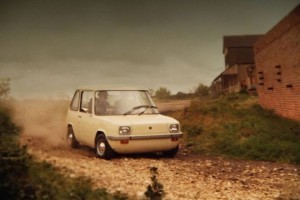It is not widely known that back in 1973, an electric car was manufactured in the Greek island of Syros from the company Enfield-Neorion, owned at the time by the famous ship owner John Goulandris.
Enfield Automotive was a small british firm based on the Isle of Wight. During the late 60s, the company was bought by the Greek millionaire John Goulandris. The forthcoming energy crisis of the 70s, led the British Electricity Council to announce a contest for the design of an electric urban vehicle. Among the proposals from Ford, Leyland and Enfield, the latter managed to surpass all the tests and eventually won the contract for an initial production of 100 vehicles.
(The production model, called Enfield E8000, was designed by a small team led by Constantine Adraktas, the Chairman and Managing Technical Director of Enfield)
The E8000 had an aluminium body based on a tubular steel chassis with a total weight of 975 kg including the batteries. It’s aerodynamic form was truly ahead of it’s time, with a very low wind resistance of 0.28 cd – a number that is still impressive even by today’s standards. Power came from an 6kW electric motor which allowed a top speed of around 75 km/h. The car was destined for urban use with a range of 80 km, depending on the driving conditions.
It is said that the former US president Ronald Reagan who was the Governor of California at the time, had three E8000 transported to Los Angeles and San Francisco for demonstration purposes, in order to support his Clean Air Act. However owner John Goulandris made the call to move the factory to Syros, incorporating Enfield Automotive with Neorion Shipyards. This decision led to Constantinos Adraktas’ resignation, as he believed that the project was destined to fail in the Greek island, due to manufacturing costs.
(From the right corner you can see Constantinos Adraktas, Chairman and Managing Technical Director of Enfield, and on his left, John Goulandris, the owner of Enfield-Neorion)
Greek workers with a background of repairing small boats or working in the shipyard, had no previous experience on building cars. However, after lots of hard work and with the help of British Designer John Ackroyd who communicated with non-English speaking staff using hand sketches, the first car rolled off the production line. The aluminium body was shaped on wooden moulds using hammers but most of the spare parts needed for the production spent days stuck on Greek customs office, adding costs and delaying the manufacturing process. There were also plans for other versions of the vehicle with more simple flat panel bodywork that would make it cheaper to manufacture.
(The full staff poses for the camera as first model of Enfield-Neorion E8000 rolls off the production line in Hermoupolis, Syros)
Unfortunately, the car didn’t get a registration approval from the Greek government, and was never sold in Greece, even though Goulandris appointed one of the top Junta members as the Managing Director of his company. Tragically, the official reason why the car wouldn’t be approved was the lack of an internal combustion engine which led to tax categorization issues. Prototypes were illegally driven on the road, having no other option as the officials wouldn’t even approve licence plates for testing purposes. Ironically, all of the 120 examples produced in Hermoupolis between 1973 and 1976 had to be exported back to Britain in order to be sold to customers all around the world. It is said that on the same day the factory was closed down, a new order of 100 more cars came from Europe but it was too late because John Goulandris had already made his decision.
Up to this date, automotive journalists question Goulandris’ controversial decision to manufacture the car in Syros, because it doesn’t seem to be driven by pure logic. Some say that the Greek millionaire wanted a product Made in Greece, but others support a different theory that wants oil companies with whom John Goulandris had a strong connection as a ship owner, to be responsible for the failure of this electric car. There are also claims that during the oil crisis, most of the tankers were idle in the port of Piraeus in contrast with Goulandris’ fleet of 60 tankers which were operating, sparkling the conspiracy theories.
Today there are a few surviving examples of the Enfield E8000 all around the world – there is even one still being used as a daily driver in Adelaide. In 2014, Michalis Stavropoulos, the Editorial Director of the Greek automotive magazine “4Troxoi” wrote, produced and directed the film “A Tale of Two Isles” which sheds light on the forgotten story of this small car. During the making of the film, a well preserved orange Enfield E8000 returned to Hermoupolis where it is still on display as an important part of the history of the island. Lastly, in 2016, british motoring journalist Jonny Smith heavily modified his E8000 nicknamed “Flux Capacitor”, making it the fastest street legal electric car in the world and proving the capabilities of it’s original aerodynamic design.
Irrespective of the reason that led to the closing or Enfield-Neorion, we must acknowledge the big opportunity Greece had in the 70s, to establish itself among the motor vehicle manufacturing countries. Aside Enfield-Neorion, numerous other companies like NAMCO, MEBEA and MAVA-Renault were producing their own vehicles, but somehow all of them gradually disappeared. Some say the death of the Greek automotive industry occurred due to the lack of political initiatives that would benefit a locally made vehicle over its competitors, whereas others blame the companies for their difficulty to compete in a higher level.
(A prototype of the electric car made in Greece is being tested in Hermoupolis, Syros)
Source: neoskosmos
Ask me anything
Explore related questions










